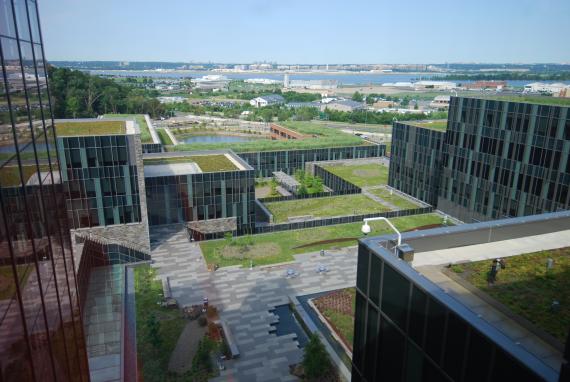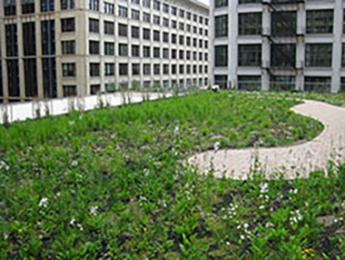SF Tool: Green Roofs Page
See green roofs guidance, information & tips on the SF Tool.

An official website of the United States government
Here’s how you know
Official websites use .gov
A .gov website belongs to an official government organization in the United States.
Secure .gov websites use HTTPS
A lock
( )
or https:// means you’ve safely connected to the .gov website. Share sensitive information only on official, secure websites.

Green roofs — also known as ‘vegetated roofs’ or ‘living roofs’ — are ballasted roofs consisting of a waterproofing membrane, growing medium (soil) and vegetation (plants) overlying a traditional roof. Well-designed, engineered and maintained green roofs provide multiple environmental, social, economic and aesthetic benefits.
GSA, which currently maintains nearly 2 million square feet of green roofs, has a long history of constructing and maintaining successful green roofs, dating back to the 1930’s. Information about green roofs at GSA can be found on the agency’s Green Roof Tracker. More guidance and information about green roofs can be found at SF Tool.
Examples of GSA buildings with green roofs include:
Full report: The Benefits and Challenges of Green Roofs on Public and Commercial Buildings [PDF - 9 MB]
This report, commissioned by the Office of Federal High Performance Green Buildings, includes a literature review of 200 research studies, in-depth analysis of green roof benefits, an original cost-benefit analysis, discussion of challenges and best practices, and assessment of further research needs.
The benefits section of the report includes:

The report includes the cost benefit analysis for green roofs as well, and offers data including:
The report discusses best practices in detail on topics, including:
The report outlines research needs, including:
Visit SFTool.gov for more information on green roofs.
See green roofs guidance, information & tips on the SF Tool.
Green Roofs can:
Green Roofs: Benefits, Costs, Challenges & Opportunities:
Summary of GSA’s green roof report and its findings, from a presentation to the 2011 GreenGov Conference in Washington, DC:
Green Roofs: Benefits, Costs, Challenges & Opportunities
US EPA Green Roofs:
www.epa.gov/heatislands/using-green-roofs-reduce-heat-islands
The US Environmental Protection Agency provides information on green roofs as part of its Heat Island Mitigation program.
National Park Service:
Installing Green Roofs on Historic Buildings
www.nps.gov/tps/standards/applying-rehabilitation/its-bulletins/ITS54-GreenRoofs.pdf
As part of the Secretary of the Interior’s Standards for Rehabilitation, the National Park Service provides guidance on how to properly install green roofs on historic buildings.
Error, The Per Diem API is not responding. Please try again later.
No results could be found for the location you've entered.
Rates for Alaska, Hawaii, and U.S. territories and possessions are set by the Department of Defense.
Rates for foreign countries are set by the Department of State.
Rates are available between 10/1/2022 and 09/30/2025.
The End Date of your trip can not occur before the Start Date.
Traveler reimbursement is based on the location of the work activities and not the accommodations, unless lodging is not available at the work activity, then the agency may authorize the rate where lodging is obtained.
Unless otherwise specified, the per diem locality is defined as "all locations within, or entirely surrounded by, the corporate limits of the key city, including independent entities located within those boundaries."
Per diem localities with county definitions shall include"all locations within, or entirely surrounded by, the corporate limits of the key city as well as the boundaries of the listed counties, including independent entities located within the boundaries of the key city and the listed counties (unless otherwise listed separately)."
When a military installation or Government - related facility(whether or not specifically named) is located partially within more than one city or county boundary, the applicable per diem rate for the entire installation or facility is the higher of the rates which apply to the cities and / or counties, even though part(s) of such activities may be located outside the defined per diem locality.